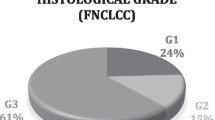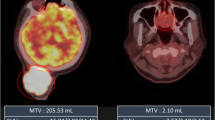Abstract
Introduction
Soft-tissue sarcomas (STS) are rare types of tumors that have variable levels of tumor differentiation. F-18 fluorodeoxyglucose positron emission tomography (FDG PET) has been established as an useful tool for STS patients, and the metabolic tumor volume (MTV) and total lesion glycolysis (TLG) are reported to be useful in various cancers. We compared the diagnostic value of four PET parameters (maximum standardized uptake value [SUVmax], SUVmean, MTV, and TLG) from two acquisition timings for predicting the expression of the pathological marker of cell proliferation Ki-67, based on pathological investigation.
Materials and methods
In this retrospective study, we investigated 20 patients (59 ± 19 years old, 18–87 years old) with pathologically confirmed STS who underwent FDG PET before surgical intervention. The patients fasted ≥ 6 h before the intravenous injection of FDG. The whole body was scanned twice; at an early phase (61.5 ± 2.6 min) and at a delayed phase (118.0 ± 2.1 min) post-injection. The SUVmax, SUVmean, MTV, and TLG of the primary lesion were measured with a tumor boundary determined by SUV ≥ 2.0. Ki-67 was measured using MIB-1 immunohistochemistry. We used Pearson’s correlation coefficient to analyze the relationships between the PET parameters and Ki-67 expressions. The Kaplan–Meier analysis with the log-rank test was performed to compare overall survival between high-group and low-group at each of the four PET parameters and Ki-67 expression.
Results
All four PET parameters at each phase showed significant correlations with Ki-67. Among them, the Pearson’s correlation coefficient (r) was largest for TLG (r = 0.76 and 0.77 at the early and delayed phases, respectively), followed by MTV (0.70 and 0.72), SUVmax (r = 0.65 and 0.66), and SUVmean (r = 0.62 and r = 0.64). From early to delayed phases, the SUVmax and SUVmean both increased in all 20 patients, whereas the MTV and TLG increased in 13/20 (65%) and 16/20 (80%) patients, respectively. None of the %increases of the PET parameters were significantly correlated with Ki-67. The overall survival was shorter for high-SUVmax, high-SUVmean, high-TLG, and high-Ki-67 groups than the other groups, although the difference did not reach statistical significance.
Conclusion
The SUVmax, SUVmean, MTV, and TLG acquired at both 1 and 2 h after injection showed significant correlations with Ki-67. Among them, correlation coefficient with Ki-67 expression was highest for TLG, although the best parameter should be determined in a larger population. The delayed-phase FDG PET was equally useful as that of early-phase to predict tumor aggressiveness in STS.






Similar content being viewed by others
Abbreviations
- CT:
-
Computed tomography
- DRAMA:
-
Dynamic row-action maximum likelihood algorithm
- FDG:
-
Fluorodeoxyglucose
- FLT:
-
Fluorothymidine
- FNCLCC:
-
Federation National des Centres de Lutte Contre le Cancer
- FOV:
-
Field of view
- H&E:
-
Hematoxylin and eosin
- MET:
-
Methionine
- MTV:
-
Metabolic tumor volume
- OS:
-
Overall survival
- PET:
-
Positron emission tomography
- RAMLA:
-
Row-action maximum likelihood algorithm
- STS:
-
Soft-tissue sarcomas
- SUV:
-
Standardized uptake value
- SUVmax:
-
Maximum of SUV
- SUVmean:
-
Mean of SUV
- TLG:
-
Total lesion glycolysis
- US:
-
Ultrasound
References
Ha SC, Oh JS, Roh J-L, Moon H, Kim JS, Cho K-J, et al. Pretreatment tumor SUVmax predicts disease-specific and overall survival in patients with head and neck soft tissue sarcoma. Eur J Nucl Med Mol Imaging. 2017;44:33–40.
Liu C-YC-L, Yen C-C, Chen W-M, Chen T-H, Chen PC-H, Wu H-TH, et al. Soft tissue sarcoma of extremities: the prognostic significance of adequate surgical margins in primary operation and reoperation after recurrence. Ann Surg Oncol. 2010;17:2102–11.
Been LB, Suurmeijer AJH, Elsinga PH, Jager PL, van Ginkel RJ, Hoekstra HJ. 18F-Fluorodeoxythymidine PET for evaluating the response to hyperthermic isolated limb perfusion for locally advanced soft-tissue sarcomas. J Nucl Med. 2007;48:367–72.
Ghigi G, Micera R, Maffione AM, Castellucci P, Cammelli S, Ammendolia I, et al. 11C-methione vs. 18F-FDG PET in soft tissue sarcoma patients treated with neoadjuvant therapy: preliminary results. In Vivo. 2009;23(1):105–10.
Kao CH, Lin SC, Hsieh TC, Yen KY, Yang SN, Wang YC, et al. Use of pretreatment metabolic tumour volumes to predict the outcome of pharyngeal cancer treated by definitive radiotherapy. Eur J Nucl Med Mol Imaging. 2012;39:1297–305.
Lim R, Eaton A, Lee NY, Setton J, Ohri N, Rao S, et al. 18F-FDG PET/CT metabolic tumor volume and total lesion glycolysis predict outcome in oropharyngeal squamous cell carcinoma. J Nucl Med. 2012;53:1506–13.
Lee JW, Cho A, Lee JH, Yun M, Lee JD, Kim YT, et al. The role of metabolic tumor volume and total lesion glycolysis on 18F-FDG PET/CT in the prognosis of epithelial ovarian cancer. Eur J Nucl Med Mol Imaging. 2014;41:1898–906.
Im H-J, Pak K, Cheon GJ, Kang KW, Kim S-J, Kim I-J, et al. Prognostic value of volumetric parameters of 18F-FDG PET in non-small-cell lung cancer: a meta-analysis. Eur J Nucl Med Mol Imaging. 2014;42:241–51.
Byun BH, Kong C-B, Park J, Seo Y, Lim I, Choi CW, et al. Initial metabolic tumor volume measured by 18F-FDG PET/CT can predict the outcome of osteosarcoma of the extremities. J Nucl Med. 2013;54:1725–32.
Guillou L, Coindre JM, Bonichon F, Nguyen BB, Terrier P, Collin F, et al. Comparative study of the National Cancer Institute and French Federation of Cancer Centers Sarcoma Group grading systems in a population of 410 adult patients with soft tissue sarcoma. J Clin Oncol. 1997;15:350–62.
Pisters PW, Leung DH, Woodruff J, Shi W, Brennan MF. Analysis of prognostic factors in 1041 patients with localized soft tissue sarcomas of the extremities. J Clin Oncol. 1996;14:1679–89.
Neuville A, Chibon F, Coindre J-M. Grading of soft tissue sarcomas: from histological to molecular assessment. Pathology. 2014;46:113–20.
Hasegawa T, Yokoyama R, Lee YH, Shimoda T, Beppu Y, Hirohashi S, et al. Prognostic relevance of a histological grading system using MIB-1 for adult soft-tissue sarcoma. Oncology. 2000;58:66–74.
Rakheja R, Makis W, Skamene S, Nahal A, Brimo F, Azoulay L, et al. Correlating metabolic activity on 18F-FDG PET/CT with histopathologic characteristics of osseous and soft-tissue sarcomas: a retrospective review of 136 patients. Am J Roentgenol. 2012;198:1409–16.
Walter F, Federman N, Apichairuk W, Nelson S, Phelps ME, Allen-Auerbach M, et al. 18F-fluorodeoxyglucose uptake of bone and soft tissue sarcomas in pediatric patients. Pediatr Hematol Oncol. 2011;28:579–87.
Yamamoto Y, Nishiyama Y, Ishikawa S, Nakano J, Chang SS, Bandoh S, et al. Correlation of 18F-FLT and 18F-FDG uptake on PET with Ki-67 immunohistochemistry in non-small cell lung cancer. Eur J Nucl Med Mol Imaging. 2007;34:1610–16.
Buck AK, Halter G, Schirrmeister H, Kotzerke J, Wurziger I, Glatting G, et al. Imaging proliferation in lung tumors with PET: 18F-FLT versus 18F-FDG. J Nucl Med. 2003;44:1426–31.
Avril N, Menzel M, Dose J, Schelling M, Weber W, Jänicke F, et al. Glucose metabolism of breast cancer assessed by 18F-FDG PET: histologic and immunohistochemical tissue analysis. J Nucl Med. 2001;42:9–16.
Tanaka E, Kudo H. Subset-dependent relaxation in block-iterative algorithms for image reconstruction in emission tomography. Phys Med Biol. 2003;48:1405–22.
Hirata K, Kobayashi K, Wong KP, Manabe O, Surmak A, Tamaki N, et al. A semi-automated technique determining the liver standardized uptake value reference for tumor delineation in FDG PET-CT. PLoS One. 2014;9:e105682.
Vander Heiden MG, Cantley LC, Thompson CB. Understanding the Warburg effect: the metabolic requirements of cell proliferation. Science. 2009;324:1029–33.
Watanabe R, Tomita N, Takeuchi K, Sakata S, Tateishi U, Tanaka M, et al. SUVmax in FDG-PET at the biopsy site correlates with the proliferation potential of tumor cells in non-Hodgkin lymphoma. Leuk Lymphoma. 2010;51:279–83.
Liao S, Penney BC, Wroblewski K, Zhang H, Simon CA, Kampalath R, et al. Prognostic value of metabolic tumor burden on 18F-FDG PET in nonsurgical patients with non-small cell lung cancer. Eur J Nucl Med Mol Imaging. 2012;39:27–38.
Liu J, Dong M, Sun X, Li W, Xing L, Yu J. Prognostic value of 18F-FDG PET/CT in surgical non-small cell lung cancer: a meta-analysis. PLoS One. 2016;11:e0146195.
Satoh Y, Nambu A, Ichikawa T, Onishi H. Whole-body total lesion glycolysis measured on fluorodeoxyglucose positron emission tomography/computed tomography as a prognostic variable in metastatic breast cancer. BMC Cancer. 2014;14:525.
Kim JW, Oh JS, Roh J-L, Kim JS, Choi S-H, Nam SY, et al. Prognostic significance of standardized uptake value and metabolic tumour volume on 18F-FDG PET/CT in oropharyngeal squamous cell carcinoma. Eur J Nucl Med Mol Imaging. 2015;42:1353–61.
Ryu IS, Kim JS, Roh J-L, Lee JH, Cho K-J, Choi S-H, et al. Prognostic value of preoperative metabolic tumor volume and total lesion glycolysis measured by 18F-FDG PET/CT in salivary gland carcinomas. J Nucl Med. 2013;54:1032–8.
Park SY, Cho A, Yu WS, Lee CY, Lee JG, Kim DJ, et al. Prognostic value of total lesion glycolysis by 18F-FDG PET/CT in surgically resected stage IA non-small cell lung cancer. J Nucl Med. 2015;56:45–9.
Kitao T, Hirata K, Shima K, Hayashi T, Sekizawa M, Takei T, et al. Reproducibility and uptake time dependency of volume-based parameters on FDG-PET for lung cancer. BMC Cancer. 2016;16:576.
Liu H, Chen P, Wroblewski K, Hou P, Zhang C-P, Jiang Y, et al. Consistency of metabolic tumor volume of non-small-cell lung cancer primary tumor measured using 18F-FDG PET/CT at two different tracer uptake times. Nucl Med Commun. 2016;37:50–6.
Wahl RL, Jacene H, Kasamon Y, Lodge MA. From RECIST to PERCIST: evolving considerations for PET response criteria in solid tumors. J Nucl Med. 2009;50:122S–50S.
Houseni M, Chamroonrat W, Zhuang J, Gopal R, Alavi A, Zhuang H. Prognostic implication of dual-phase PET in adenocarcinoma of the lung. J Nucl Med. 2010;51:535–42.
Chen HHW, Lee B-F, Su W-C, Lai Y-H, Chen H-Y, Guo H-R, et al. The increment in standardized uptake value determined using dual-phase 18F-FDG PET is a promising prognostic factor in non-small-cell lung cancer. Eur J Nucl Med Mol Imaging. 2013;40:1478–85.
Acknowledgements
We would like to thank Eriko Suzuki for her great support in the preparation of this manuscript. We would also like to thank the members of the department of Nuclear Medicine, Hokkaido University for their hospitality during the research.
Funding
Funding information is not applicable.
Author information
Authors and Affiliations
Contributions
Design of the study: TK, KH. Investigation: TK, TS, KH, NT. Formal analysis: TK, KY. Software: KH. Supervision: TS, MS, TT, KY, NT. Writing—original draft: TK, KH. Writing—review & editing: TK, TS, KH, MS, TT, KY, NT.
Corresponding author
Ethics declarations
Conflict of interest
The authors declare that they have no conflict of interests.
Ethics approval and informed consent
This retrospective study was approved by the institutional ethics committee of Hokkaido Cancer Center. The informed consent was waived from individual participants in the retrospective study according to the institutional ethics committee of Hokkaido Cancer Center (#27-43). Patient records/information was anonymized and de-identified prior to analysis.
Research involving human participants
All procedures performed in studies involving human participants were in accordance with the ethical standards of the institutional and/or national research committee and with the 1964 Helsinki declaration and its later amendments or comparable ethical standards.
Electronic supplementary material
Below is the link to the electronic supplementary material.
Rights and permissions
About this article
Cite this article
Kitao, T., Shiga, T., Hirata, K. et al. Volume-based parameters on FDG PET may predict the proliferative potential of soft-tissue sarcomas. Ann Nucl Med 33, 22–31 (2019). https://doi.org/10.1007/s12149-018-1298-0
Received:
Accepted:
Published:
Issue Date:
DOI: https://doi.org/10.1007/s12149-018-1298-0




